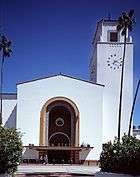Chandler (film)
Chandler (also known as Open Shadow) is a 1971 American neo-noir[1] film directed by Paul Magwood and based on a story of his own creation. The film stars Warren Oates as a man with the single name of Chandler: "as in Raymond", he says at one point. It co-stars Leslie Caron, married at the time to the film's producer, Michael Laughlin. Cameo roles feature Gloria Grahame and Scatman Crothers.
| Chandler | |
|---|---|
.jpg) | |
| Directed by | Paul Magwood |
| Produced by | Michael Laughlin |
| Screenplay by | John Sacret Young |
| Story by | Paul Magwood |
| Starring | Warren Oates Leslie Caron Alex Dreier |
| Music by | George Romanis |
| Cinematography | Alan Stensvold |
| Edited by | William B. Gulick Richard A. Harris |
| Distributed by | Metro-Goldwyn-Mayer |
Release date |
|
Running time | 85 minutes |
| Country | United States |
| Language | English |
Plot

In a deliberate throwback to 1940s films noir, a former private eye from that period, Chandler, takes up his old work again, and finds himself constantly driving old cars. He is ostensibly hired by the government to protect a witness, Katherine Creighton, from a gangland leader, John Melchior, who wants to kill her. But Chandler is in fact working for a corrupt government agent, Ross J. Carmady, who is using him as a dupe so that Carmady can murder Melchior and put his own double agent at the top of the racket.
After quitting a position as a security guard, Chandler is offered a job by old friend Bernie Oakman, unaware that Bernie's been asked by Carmady to find a suitable patsy. Chandler gets his gun back from a pawn shop and follows the French woman Creighton from the moment of her arrival in Los Angeles. He becomes acquainted with her on a train to Monterey, California without revealing that he is tailing her, but soon intervenes when Creighton is assaulted and thrown into the trunk of a car.
Chandler becomes romantically involved with the woman, against his better judgment, repeatedly telling her, "You'll do." The two of them end up trapped near an isolated beach, ambushed by Carmady and his associate Kincaid, shooting it out.
Cast
- Warren Oates as Chandler
- Leslie Caron as Katherine Creighton
- Alex Dreier as Ross J. Carmady
- Marianne McAndrew as Angel Carter
- Mitch Ryan as Charles "Chuck" Kincaid
- Gordon Pinsent as John Melchior
- Charles McGraw as Bernie Oakman
- Walter Burke as Zeno
- Richard Loo as Leo
- Gloria Grahame as Selma
- Scatman Crothers as Smoke
Production
The scene on the train begins with an incorrect establishing shot. The train shown is a Chicago, Burlington and Quincy Railroad passenger train, which never operated in California.
Scenes on board the passenger train feature people purchasing food from vending machines in a Southern Pacific Automat Buffet car.
Producer Michael S. Laughlin and director Paul Magwood were irate at the involvement of MGM studio head James Thomas Aubrey, Jr. in the film's production. They went to the length of taking out a full page, black-bordered ad in the trade papers declaring:
Regarding what was our film Chandler, let's give credit where credit is due. We sadly acknowledge that all editing, post-production as well as additional scenes were executed by James T. Aubrey Jr. We are sorry.[2][3][4]
References
- Silver, Alain; Ward, Elizabeth; eds. (1992). Film Noir: An Encyclopedic Reference to the American Style (3rd ed.). Woodstock, New York: Overlook Press. ISBN 0-87951-479-5
- Martin Kasindorf. "How now, Dick Daring?" The New York Times Magazine. September 10, 1972. 54+.
- "Uprising at MGM.", Time, December 27, 1971, retrieved January 24, 2008
- Warga, Wayne (26 Dec 1971), "What's Going On in the Lion's Den at MGM?: What's Going On", Los Angeles Times, q1
External links
- Chandler on IMDb
- Chandler at the TCM Movie Database
- Chandler at AllMovie
- Chandler at the American Film Institute Catalog